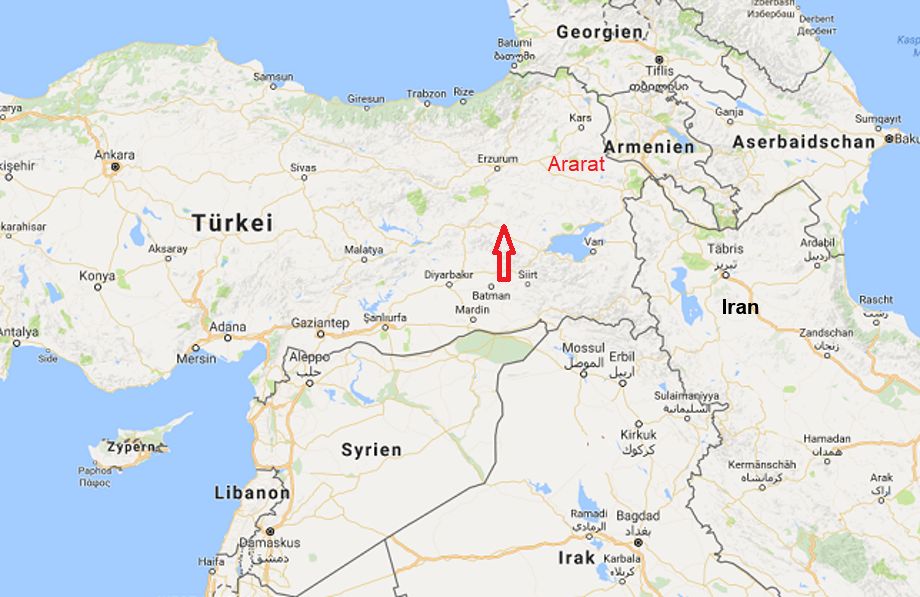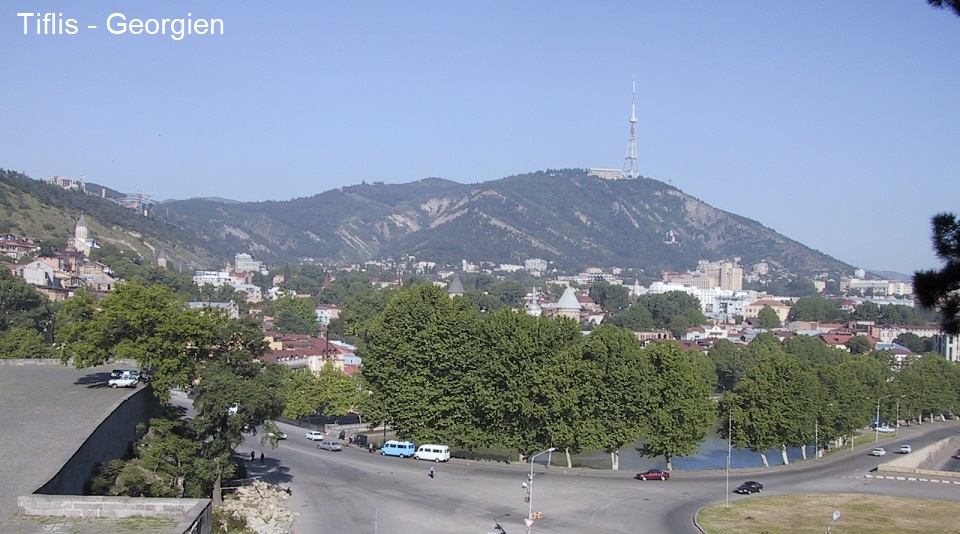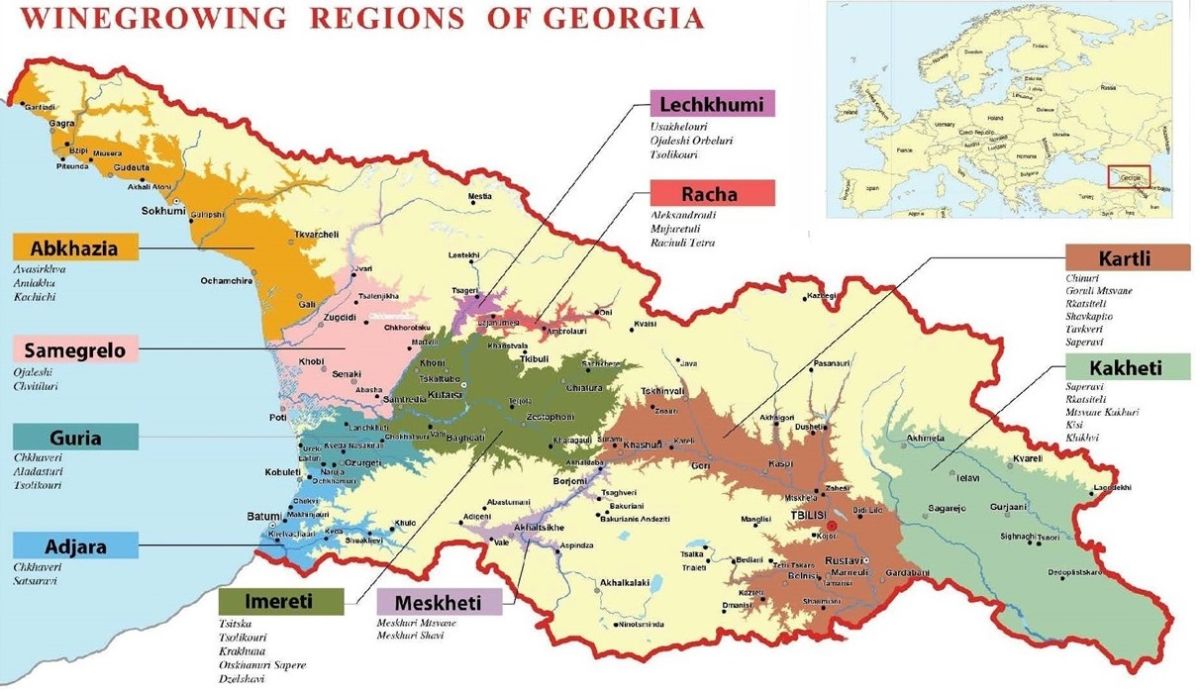Results
2,284 Results
Loading more Results ...
Loading more Results ...
Wine regions in Georgia 4 growing regions
Description to Georgia
The state of Georgia (Georgian: Sakartvelo) in the Near East) with the capital Tbilisi covers 69,700 km² (including Abkhazia and South Ossetia) and 57,215 km² (excluding). The former USSR state became independent in 1991 after the collapse of the Soviet Union. It is located east of the Black Sea in the South Caucasus (see Transcaucasia). It is bordered by Russia to the north, Turkey and Armenia to the south and Azerbaijan to the east. The two parts of the country, Abkhazia and South Ossetia, are occupied by Russian forces and are not under the control of the Georgian government. They are only recognised as sovereign by Russia and a few other states.

History
Georgia is one of the oldest wine-growing countries and is also cited as the origin of the cultivated grapevine, which according to recent research is thought to have originated in south-east Anatolia (arrow). According to the Bible, Noah landed on Mount Ararat after the end of the Flood. The 5,000-year-old clay jars found near the city of Wani in Imeretia are said to have contained seeds of the Rkatsiteli grape. Grape seeds from cultivated vines that are already 7,000 years old point to the cultivation of better grape varieties.
Archaeology has provided evidence that viticulture was of great importance from the earliest times and was an integral part of Georgian culture. The museum in the capital Tbilisi houses a short piece of vine wood covered in silver, which was found in Trialeti in the south and has been dated to 3,000 BC. Numerous vine knives, stone candlesticks, mills, clay and metal vessels as well as jewellery in the form of grapes and vine leaves from the period between 3000 and 2000 BC were excavated in Mukheta, Trialeti and Pitsunda as well as in the Alazani Valley.

Rich ornaments with fruit-covered vines can be found on the walls of temples in the cities of Samtavisi, Ikalto, Gelati, Nikortsminda, Vardzia and Zarmza. A poem by the Greek scholar Apollonius of Rhodes (3rd century BC), the librarian of the famous library in Alexandria, states in his work "Argonautica" that the Argonauts (heroes of Greek mythology) saw climbing vines at the entrance to the royal palace and a fountain of wine in the shade of the trees when they arrived in the capital of Colchis. Georgian legends bear witness to the love of the vine. Georgia adopted Christianity in the fourth century. The first cross was allegedly made from vines to demonstrate the Christian religion and the vine as the country's most sacred assets. For many centuries, viticulture was of great economic importance in Georgia and finally reached an absolute peak in the Middle Ages.
Viticulture in modern times
After the Second World War (1939-1945), Georgia developed into an important wine supplier in the USSR, focussing on mass-produced wines. By 1985, the area under vines had increased to 125,000 hectares. Then the anti-alcohol campaign under Mikhail Gorbachev (*1931) caused a major setback, as 40,000 hectares of vineyards were cleared and replaced by melon cultivation. At the time of independence in 1991, 75% of production was exported to Russia. In 2006, however, there was a ban on imports (of Moldovan wines as well), which was justified by Russia on the grounds that Georgian wines were unfit for consumption due to contamination with pesticides and harmful substances. Georgia saw this as politically motivated action against the new pro-Western government. The Georgian wine industry was massively affected by this. The embargo was lifted at the end of 2011.

Regions & wine-growing areas
Under the wind-protecting influence of the towering Caucasus Mountains, there are ideal climatic conditions for viticulture in various forms. The wine-growing regions are characterised by diverse soil conditions and are spread throughout the country. The focus is on the east of the country. From a climatic point of view, there are 5 regions: Guria, Imeretia, Kakheti, Kartlia and Racha-Lechkhumi. These are divided into 12 wine-growing regions.

Guria (Guria)
The region with the capital Osugeti comprises the western areas of Abkhazia (Abkhazia), Adjara (Adjara), Guria (Guria) and Megrelia/Mingrelia (Samegrelo). In the humid subtropical climate, mainly sweet wines are produced, which are almost exclusively destined for the regional market. The only PDO area is Salkhino Ojaleshi.
Imeretia (Imereti)
The region with the capital Kutaisi is located in western Georgia in the wind-protected valleys of the Rioni and Kvirila rivers on alluvial soils. It is divided into the areas of Kvemo Imereti and Zemo Imereti. There are different climatic and soil conditions with frequent rainfall. The traditional winemaking method used here with clay jars buried in the ground is similar to the Kakhetian method. The only PDO area is Sviri.
Kakheti (Kakheti)
The most important region in the east with the capital Telavi. This is also where most of the PDO areas with protected origin are located (see under Kakheti). This is also the home of the ancient, traditional Kakhetian winemaking with clay jugs (kvevris) buried in the ground. The climate is temperate to subtropical, with warm summers and moderately cold winters. The average annual precipitation is between 400 and 800 mm. Calcareous soils, alluvial soils and black slate prevail. Most of the vineyards are located on the slopes of the Alazani and Iori rivers between 250 and 800 metres above sea level. The traditional dessert Churchkhela, which is made from nuts dipped in boiled grape must and dried in the sun, also comes from here.
Kartli (Kartli)
The region is located in the centre of the country in the Kura Valley and surrounds the lowlands of Gori and Mukhran. It includes the Georgian administrative regions of Lower Kartli (Kvemo Kartli), Mtskheta-Mtianeti, Inner Kartli (Shida Kartli), Tbilisi and thus also South Ossetia. This is where the base wines for sparkling wine and brandy are produced, which account for 15% of Georgian production. The climate is moderate with hot and dry summers. Due to the low rainfall of only 350 to 500 mm per year, artificial irrigation is necessary.
The Georgian capital Tbilisi is home to huge sparkling wine cellars and distilleries. The oldest winery, founded in 1897, has a unique wine collection with around 1,600 wines (around 150,000 bottles), including foreign products from very old vintages. These include Cognac from 1811, Malaga from 1820, Marsala and Madeira from 1822, Sherry from 1848 and Tokay from 1846. There are four PDO areas: Asuretuli Shala, Ateni, Bolnisi and Okami.
Racha-Lechkhumi (Racha-Lechkhumi)
The region with the capital Ambrolauri lies to the north of Imeretia on the Rioni and Tskhenistskali rivers. The climate is characterised by moderately cold winters and hot, dry summers. The south-facing vineyards produce grapes with a high sugar content. There are the PDO areas Khvanchkara( Josef Stalin's favourite wine ), Okureshis Usakhelouri and Tvishi.
Wines with protected designation of origin (PDO)
There are 29 PDO areas or wines (most of them from Kakheti) for which there are regulations regarding grape varieties and ageing. These are Akhasheni, Akhmeta, Akhoebi, Asuretuli Shala, Atenuri, Bolnisi, Gurjaani, Kakheti, Kardenakhi, Khashmi Saperavi, Khvanchkara, Kindzmarauli, Kothekhi, Kvareli, Maghraani Kisi, Manavi, Mukuzani, Napareuli, Okami, Okureshis Usakhelouri, Salkhino Ojaleshi, Sviri, Teliani, Tibaani, Tsarapi, Tsinandali, Tvishi, Vazisubani and Zegaani.
Vineyards & grape varieties
In 2022, the vineyards covered 49,450 hectares of vines and the wine production volume was 2.14 million hectolitres. Around two thirds are planted with red wine varieties and one third with white wine varieties. Wild vines are still widespread in Georgia; the species Vitis vinifera sylvestris is still represented here today. There are over 500 indigenous grape varieties, but only around 10% of these are authorised for viticulture. There is a vine nursery in Sakar. The grape variety catalogue (Kym Anderson):
Grape variety |
Colour |
Synonyms |
Hectare |
| Rkatsiteli | white | - | 25.324 |
| Tsolikouri | white | Melquos Tsolikouri, Zolikouri | 7.903 |
| Saperavi | red | - | 4.751 |
| Tsitska | white | Shanti, Tsitsiko | 3.642 |
| Chinuri | white | Tchonouri | 1.225 |
| Mtsvane Kakhuri | white | Dedali Mtsvane | 319 |
| Goruli Mtsvane | white | Kvishkhuri, Tetrpotola | 287 |
| Cabernet Sauvignon | red | - | 286 |
| Aleksandrouli | red | Alexandrouli, Kabistoni | 281 |
| Pinot Blanc | white | - | 219 |
| Tsulukidzis Tetra | white | Rachuli Tetra | 195 |
| Aligoté | white | Mukhranuli | 124 |
| Aladasturi | red | Aladastouri | 59 |
| Krakhuna | white | Chkovra | 46 |
| Tavkveri | red | Takveri | 37 |
| Ojaleshi | red | Chonouri | 32 |
| Chkhaveri | red | Tchkhaveri | 26 |
| Kisi | white | Kissi, Maghranuli | 26 |
| Usakhelouri | red | Okhureshuli | 10 |
| Khikhvi | white | Chichvi | 6 |
| Otskhanuri Sapere | red | Argvetuli Sapere | 6 |
| Andreouli Chavi | red | Andreouli | ? |
| Asuretuli Shavi | red | Asuretuli, sonic grape | ? |
| Dzvelshavi Obchuri | red | Dzvelchavi Obtchouri, Dzvelchavi Obtshinsky | ? |
| Kachichi | red | Abkhazouri, Kagigi | ? |
| Kapistoni Tetri | white | Kapistona, Kapistoni | ? |
| Kharistvala Kolkhuri | red | Charistvala, Dodrelyabi | ? |
| Kharistvala Meskhuri | white | Meskhuri Kharistvala | ? |
| Kudurauli | white | Chaghvinauri | ? |
| Mujuretuli | red | Keduretuli | ? |
| Orbeluri | red | Orbeluri Odzhaleshi | ? |
| Saperavi Budeshuri | red | Saperavi Boudechourissebouri | ? |
| Shavkapito | red | Chavkapito | ? |
| Tchvitiluri | white | Chvitiluri | ? |
| Tskhenisdzudzu Adjharuli | red | Tskhenisdzuzu | ? |
Producers
Georgia is best known for its red wines, which were considered the best in the Union in USSR times. Many fortified wines, sparkling wines and sweet wines are also produced, as well as spirits(brandy, chacha = marc spirit). At the Yalta Conference in February 1945, Josef Stalin (1878-1953) surprised Winston Churchill (1874-1965) with the quality of "Grusinian cognac". Well-known producers include Aia, Bagrationi, Chetsuriani, Georgia Wine & Spirits, Khareba, Manavi Wine Cellar, Samkharadze & Co Ltd, Samtrest, Saradzhishvili & Eniseli, Schuchmann, Taro Ltd, Tbilvino, Telavi Wine Cellar, Teliani Valley, Tibaneli, Tsinandali (historical winery, now a museum), Vasiani, Vazi+ and Wine Company Shumi.
Map: © Goruma
Flag: by Georgia on State Symbols., Public domain, Link
Coat of arms: by Mamuka Gongadze, Public domain, Link
Historical map: by Goran tek-en - Own work, Based on Mesopotamia Syria, CC BY-SA 3.0, Link
Tbilisi: By Hans Peter Schaub - Own work, CC BY-SA 3.0, Link
Wine-growing regions: National Wine Agency of Georgia
Classified wine producers in Georgia 10
Recent wines 141
 Winery of the Future
— Kachetien
2022 Tsinandali Dry
7.10 €
Winery of the Future
— Kachetien
2022 Tsinandali Dry
7.10 €

 Winery of the Future
— Kachetien
2022 Saperavi Dry
7.20 €
Winery of the Future
— Kachetien
2022 Saperavi Dry
7.20 €


